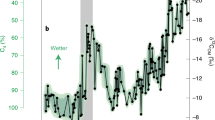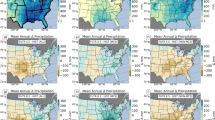Abstract
Mesoscale convective system (MCS)-organized convective storms with a size of ~100 km have increased in frequency and intensity in the USA over the past 35 years1, causing fatalities and economic losses2. However, their poor representation in traditional climate models hampers the understanding of their change in the future3. Here, a North American-scale convection-permitting model which is able to realistically simulate MSCs4 is used to investigate their change by the end-of-century under RCP8.5 (ref. 5). A storm-tracking algorithm6 indicates that intense summertime MCS frequency will more than triple in North America. Furthermore, the combined effect of a 15–40% increase in maximum precipitation rates and a significant spreading of regions impacted by heavy precipitation results in up to 80% increases in the total MCS precipitation volume, focussed in a 40 km radius around the storm centre. These typically neglected increases substantially raise future flood risk. Current investments in long-lived infrastructures, such as flood protection and water management systems, need to take these changes into account to improve climate-adaptation practices.
This is a preview of subscription content, access via your institution
Access options
Access Nature and 54 other Nature Portfolio journals
Get Nature+, our best-value online-access subscription
$29.99 / 30 days
cancel any time
Subscribe to this journal
Receive 12 print issues and online access
$209.00 per year
only $17.42 per issue
Buy this article
- Purchase on Springer Link
- Instant access to full article PDF
Prices may be subject to local taxes which are calculated during checkout




Similar content being viewed by others
References
Feng, Z. et al. More frequent intense and long-lived storms dominate the springtime trend in central US rainfall. Nat. Commun. 7, 13429 (2016).
Topics Geo: Natural Catastrophes 2015 Analyses, Assessments, Positions (Munich Re, 2016).
Prein, A. F. et al. A review on regional convection-permitting climate modeling: demonstrations, prospects, and challenges. Rev. Geophys. 53, 323–361 (2015).
Prein, A. F. et al. Simulating North American mesoscale convective systems with a convection-permitting climate model. Clim. Dynam. (in the press); https://doi.org/10.1007/s00382-017-3947-8
Clark, A. J., Bullock, R. G., Jensen, T. L., Xue, M. & Kong, F. Application of object-based time-domain diagnostics for tracking precipitation systems in convection-allowing models. Weather Forecast. 29, 517–542 (2014).
74-Year List of Severe Weather Fatalities (NOAA, 2016); http://www.nws.noaa.gov/om/hazstats.shtml
Wasko, C., Sharma, A. & Westra, S. Reduced spatial extent of extreme storms at higher temperatures. Geophys. Res. Lett. 43, 4026–4032 (2016).
Karl, T. R. Global Climate Change Impacts in the United States (Cambridge Univ. Press, Cambridge, 2009).
Trenberth, K. E., Dai, A., Rasmussen, R. M. & Parsons, D. B. The changing character of precipitation. Bull. Am. Meteorol. Soc. 84, 1205–1217 (2003).
Westra, S. et al. Future changes to the intensity and frequency of short-duration extreme rainfall. Rev. Geophys. 52, 522–555 (2014).
Liu, C. et al. Continental-scale convection-permitting modeling of the current and future climate of North America. Clim. Dynam. 49, 71–95 (2017).
Kendon, E. J. et al. Do convection-permitting regional climate models improve projections of future precipitation change? Bull. Am. Meteorol. Soc. 98, 79–93 (2017).
Prein, A. F. et al. The future intensification of hourly precipitation extremes. Nat. Clim. Change 7, 48–52 (2017).
Houze, R. A. Mesoscale convective systems. Rev. Geophys. 42, RG4003 (2004).
Fritsch, J., Kane, R. & Chelius, C. The contribution of mesoscale convective weather systems to the warm-season precipitation in the United States. J. Clim. Appl. Meteorol. 25, 1333–1345 (1986).
Diffenbaugh, N. S., Scherer, M. & Trapp, R. J. Robust increases in severe thunderstorm environments in response to greenhouse forcing. Proc. Natl Acad. Sci. USA 110, 16361–16366 (2013).
Gensini, V. A. & Mote, T. L. Downscaled estimates of late 21st century severe weather from CCSM3. Clim. Change 129, 307–321 (2015).
Trapp, R. J. et al. Changes in severe thunderstorm environment frequency during the 21st century caused by anthropogenically enhanced global radiative forcing. Proc. Natl Acad. Sci. USA 104, 19719–19723 (2007).
Romps, D. M., Seeley, J. T., Vollaro, D. & Molinari, J. Projected increase in lightning strikes in the United States due to global warming. Science 346, 851–854 (2014).
Carbone, R., Tuttle, J., Ahijevych, D. & Trier, S. Inferences of predictability associated with warm season precipitation episodes. J. Atmos. Sci. 59, 2033–2056 (2002).
Lackmann, G. M. The south-central US flood of May 2010: present and future. J. Clim. 26, 4688–4709 (2013).
Schumacher, R. S. & Peters, J. M. Near-surface thermodynamic sensitivities in simulated extreme-rain-producing mesoscale convective systems. Mon. Weather Rev. 145, 2177–2200 (2017).
Srivastava, R. A model of intense downdrafts driven by the melting and evaporation of precipitation. J. Atmos. Sci. 44, 1752–1774 (1987).
Yuter, S. E., Kingsmill, D. E., Nance, L. B. & Löffler-Mang, M. Observations of precipitation size and fall speed characteristics within coexisting rain and wet snow. J. Applied Meteorol. Clim. 45, 1450–1464 (2006).
Rasmussen, R. et al. High-resolution coupled climate runoff simulations of seasonal snowfall over Colorado: a process study of current and warmer climate. J. Clim. 24, 3015–3048 (2011).
Doswell, C. Severe Convective Storms (Springer, New York, 2015).
IPCC Climate Change 2013: The Physical Science Basis (eds Stocker, T. et al.) (Cambridge Univ. Press, Cambridge, 2014).
Shepherd, T. G. Atmospheric circulation as a source of uncertainty in climate change projections. Nat. Geosci. 7, 703–708 (2014).
Skamarock, W. C. & Klemp, J. B. A time-split nonhydrostatic atmospheric model for weather research and forecasting applications. J. Comput. Phys. 227, 3465–3485 (2008).
Thompson, G. & Eidhammer, T. A study of aerosol impacts on clouds and precipitation development in a large winter cyclone. J. Atmos. Sci. 71, 3636–3658 (2014).
Iacono, M. J. et al. Radiative forcing by long-lived greenhouse gases: calculations with the AER radiative transfer models. J. Geophys. Res. Atmos. 113, D13103 (2008).
Hong, S.-Y., Noh, Y. & Dudhia, J. A new vertical diffusion package with an explicit treatment of entrainment processes. Mon. Weather Rev. 134, 2318–2341 (2006).
Niu, G.-Y. et al. The community Noah land surface model with multiparameterization options (Noah-MP): 1. Model description and evaluation with local-scale measurements. J. Geophys. Res. Atmos. 116, D12109 (2011).
von Storch, H., Langenberg, H. & Feser, F. A spectral nudging technique for dynamical downscaling purposes. Mon. Weather Rev. 128, 3664–3673 (2000).
Langhans, W., Schmidli, J. & Schär, C. Bulk convergence of cloud-resolving simulations of moist convection over complex terrain. J. Atmos. Sci. 69, 2207–2228 (2012).
Bryan, G. H. & Morrison, H. Sensitivity of a simulated squall line to horizontal resolution and parameterization of microphysics. Mon. Weather Rev. 140, 202–225 (2012).
Lebo, Z. & Morrison, H. Effects of horizontal and vertical grid spacing on mixing in simulated squall lines and implications for convective strength and structure. Mon. Weather Rev. 143, 4355–4375 (2015).
Varble, A. et al. Evaluation of cloud-resolving and limited area model intercomparison simulations using TWP-ICE observations: 1. Deep convective updraft properties. J. Geophys. Res. Atmos. 119, D12206 (2014).
Fan, J., Wang, Y., Rosenfeld, D. & Liu, X. Review of aerosol–cloud interactions: mechanisms, significance, and challenges. J. Atmos. Sci. 73, 4221–4252 (2016).
Dee, D. et al. The ERA-Interim reanalysis: configuration and performance of the data assimilation system. Q. J. R. Meteorol. Soc. 137, 553–597 (2011).
Taylor, K. E., Stouffer, R. J. & Meehl, G. A. An overview of CMIP5 and the experiment design. Bull. Am. Meteorol. Soc. 93, 485–498 (2012).
Kröner, N. et al. Separating climate change signals into thermodynamic, lapse-rate and circulation effects: theory and application to the European summer climate. Clim. Dynam. 48, 3425–3440 (2017).
Davis, C., Brown, B. & Bullock, R. Object-based verification of precipitation forecasts. Part I: Methodology and application to mesoscale rain areas. Mon. Weather Rev. 134, 1772–1784 (2006).
Davis, C. A., Brown, B. G., Bullock, R. & Halley-Gotway, J. The method for object-based diagnostic evaluation (MODE) applied to numerical forecasts from the 2005 NSSL/SPC Spring Program. Weather Forecast. 24, 1252–1267 (2009).
Wilks, D. S. Statistical Methods in the Atmospheric Sciences Vol. 100 (Academic, Oxford, 2011).
Trier, S. B., Davis, C. A., Ahijevych, D. A. & Manning, K. W. Use of the parcel buoyancy minimum (B min) to diagnose simulated thermodynamic destabilization. Part I: Methodology and case studies of MCS initiation environments. Mon. Weather Rev. 142, 945–966 (2014).
Trier, S. B., Davis, C. A., Ahijevych, D. A. & Manning, K. W. Use of the parcel buoyancy minimum (B min) to diagnose simulated thermodynamic destabilization. Part II: Composite analysis of mature MCS environments. Mon. Weather Rev. 142, 967–990 (2014).
High Resolution WRF Simulations of the Current and Future Climate of North America (NCAR, accessed 5 August 2017); https://rda.ucar.edu/datasets/ds612.0/
Acknowledgements
NCAR is funded by the National Science Foundation (NSF) and this work was partially supported by the NSF EASM Grant AGS-1048829, by the US Army Corps of Engineers (USACE) Climate Preparedness and Resilience Program and NCAR’s Water System program. We thank the ECMWF and National Climate Data Centre for making available their datasets. Computer resources were provided by the Computational and Information Systems Laboratory (NCAR Community Computing, http://n2t.net/ark:/85065/d7wd3xhc).
Author information
Authors and Affiliations
Contributions
A.F.P designed the study, and collected and analysed the data. C.L. and K.I. performed and post-processed the climate simulations. All the authors contributed to the writing process and gave conceptual advice.
Corresponding author
Ethics declarations
Competing interests
The authors declare no competing financial interests.
Additional information
Publisher’s note: Springer Nature remains neutral with regard to jurisdictional claims in published maps and institutional affiliations.
Electronic supplementary material
Supplementary Information
Supplementary Figures 1–9 and Supplementary Table 1
Rights and permissions
About this article
Cite this article
Prein, A.F., Liu, C., Ikeda, K. et al. Increased rainfall volume from future convective storms in the US. Nature Clim Change 7, 880–884 (2017). https://doi.org/10.1038/s41558-017-0007-7
Received:
Accepted:
Published:
Issue Date:
DOI: https://doi.org/10.1038/s41558-017-0007-7
This article is cited by
-
The climate change response of alpine-mediterranean heavy precipitation events
Climate Dynamics (2024)
-
A multiscale assessment of the springtime U.S. mesoscale convective systems in the NOAA GFDL AM4
Climate Dynamics (2024)
-
Thunderstorm straight line winds intensify with climate change
Nature Climate Change (2023)
-
Large-scale dynamics moderate impact-relevant changes to organised convective storms
Communications Earth & Environment (2023)
-
Sharpening of cold-season storms over the western United States
Nature Climate Change (2023)



